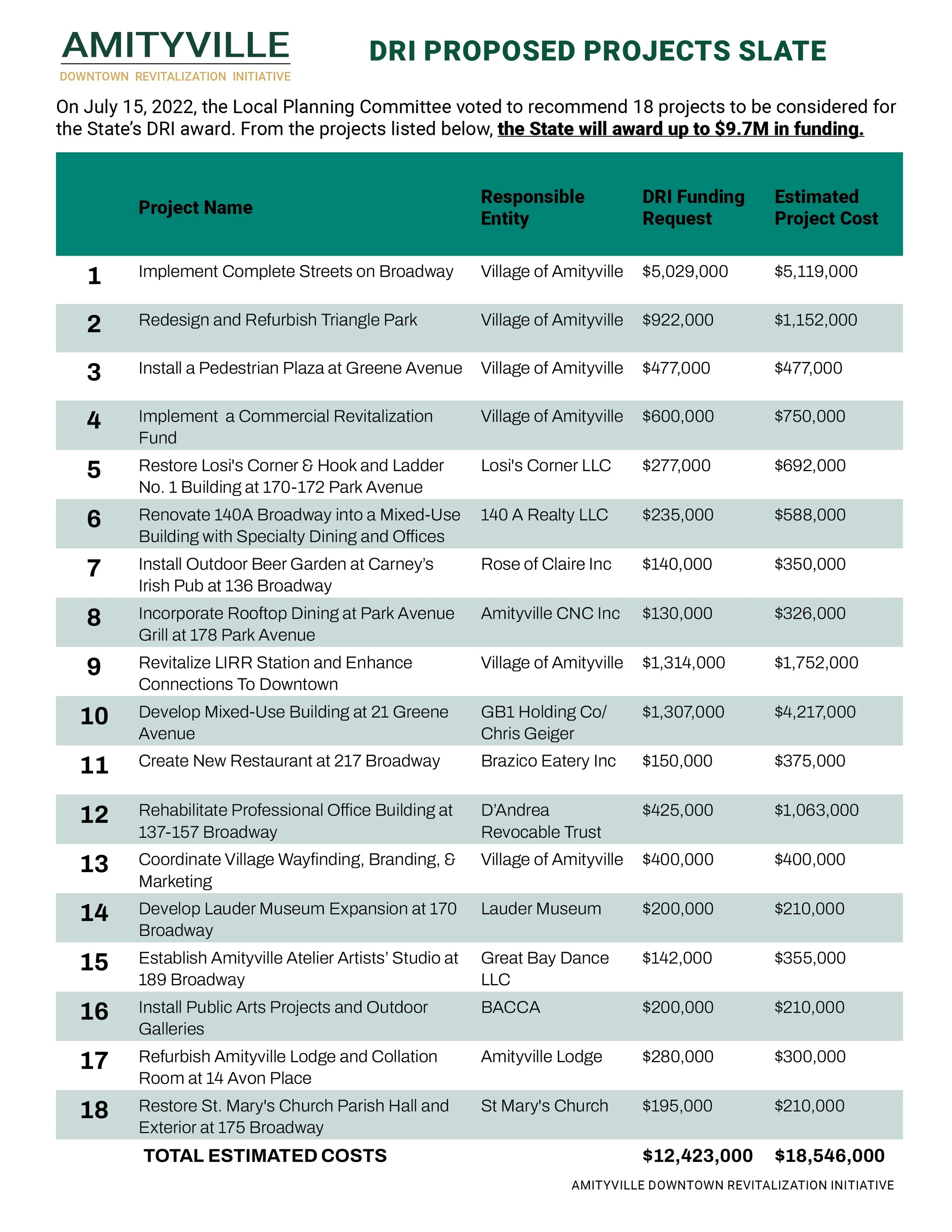Proposed Projects
DRI grant funds can be used as gap funding for eligible capital projects that have the potential to increase economic vitality and growth in the downtown.
Update 12/18: NYS announced final DRI awards on Tues. Dec. 20,10am @ Amityville Fire Department Building
Update 7/15: LPC recommends Proposed Projects. NYS will announce final DRI awards in Fall 2022.
Update 8/8: LPC recommends Proposed Projects. NYS will announce final DRI awards in Fall 2022.
Update 5/11: Submitted projects will be introduced at the Community Meeting #2 on May 10, 2022.
Update 4/20: The Call for Projects is Now Closed. Thank you for all your submissions. Further information is forthcoming. Please register for future events below.
Additional Information
-
• Public Improvement Projects:
Projects that improve the public realm, such as stormwater management, green infrastructure, streetscape improvements, transportation infrastructure, recreational trails, parking, signage, open space improvements and public art.• New Development and/or Rehabilitation of Existing Downtown Buildings:
Projects involving the development or redevelopment of properties for mixed-use, commercial, residential, or public uses.• Revolving Loan Fund or Grant: Projects or activities that could be funded through a revolving loan fund and/or grant fund. Examples include façade improvements, public art and public realm improvements, and physical improvement to existing and/or vacant commercial space.
• Branding and Marketing: Projects that improve downtown wayfinding and legibility and foster a sense of place for residents, investors, developers, and/or visitors. Costs eligible under this project type must be one-time expenses, such as the development of materials and signage. Ongoing operational costs, such as funding a downtown manager or maintaining a website, are not eligible for DRI funding.
-
• Planning Activities:
DRI funds must be used for projects that directly implement the DRI Strategic Investment Plan, which will be published at the end of the DRI planning process. Utilizing DRI funds for additional planning is not the goal of the program.• Operation and Maintenance:
DRI funds cannot be used for on-going or routine expenses, such as staff salaries and wages, rent, utilities, and property upkeep.• Pre-Award Costs:
Reimbursement for costs incurred before the DRI plan is complete and / or before funding awards are announced is not permitted.• Property Acquisition:
A DRI project profile may include the cost of acquisition in the budget of a larger development, but it must also show that the acquisition itself will be, or has already been, covered by another funding source.• Training and Other Program Expenses:
DRI is a one-time infusion of funds, and cannot be used to cover continuous costs, such as training programs, that would cease to exist once the DRI funds have been expended.• Expenses Related to Existing Programs:
DRI is not intended to supplement existing programs or replace existing resources -
Who is eligible to receive funding for a project in a DRI?
There are no restrictions on the types of entities that may receive DRI funding to undertake projects in the final DRI plan. Selected projects will enter into contracts with a relevant state agency.
How are grant awards determined? Are there pre-determined project grant amounts?
Grant awards will be determined on a project-by-project basis. Applicants should clearly indicate project funding sources, including the potential project gap that would need to be filled by DRI funding.
Will the funds be provided on a reimbursement basis or upfront?
Funds will be administered through the appropriate state agency. While there may be some variation between agency administration and the project type, awarded project funding will only be provided on a reimbursement basis.
May funds be used as match for NYS or federal grant funding?
The DRI funds may be used as match for other grant funding if permitted by the granting authority. However, the priority is to fund projects that are ready for implementation. Therefore, DRI funds should not be held as matching funds for other grants whose award or implementation cycles are in the out-years.
How and when will funds be disbursed and by what agency/agencies?
Projects selected for DRI funding will be assigned to the appropriate state agency or authority to manage implementation of the project. The state agency or authority selected, and method of funding disbursement will be dependent on the specific project.
-
The Village envisions its Downtown as a thriving, vibrant, and walkable mixed-use downtown corridor, defined by the area’s unique nautical culture, pedestrian-friendly environment, and historic charm. Downtown Amityville will be known for its culture, art, diversity, food and entertainment, and family- friendly recreational opportunities.
With improved access to the surrounding transportation network, Downtown Amityville will be better connected to housing, recreation, and job opportunities throughout the region, encouraging sustainable economic growth.
By investing in mixed-use and multi-family housing neighborhoods, Downtown Amityville will attract professionals seeking to live, work and raise a family in a suburban, but walkable environment.
Through our collaboration, we can infuse capital into Downtown Amityville and attract future investments that will spur economic growth and opportunity within the Village for decades to come.
-
Goal 1 - Support connectivity, beautification, and walkability of pedestrian environment through functional streetscapes, safer roadways and intersections, and revitalized public realm
Goal 2 - Promote future investments to enhance the unique business environment and sense of place in Downtown Amityville
Goal 3 - Improve the Amityville LIRR station and strengthen its linkages with downtown amenities and surrounding workplaces
Goal 4 - Leverage the Village’s existing Transit- Oriented and Planned Residential zoning districts to create a balance of new housing for seniors, professionals, and young families
Goal 5 - Catalyze the redevelopment of underutilized and unoccupied properties
Goal 6 - Create vibrant spaces for arts, cultural, and recreational activities and programming that serve the local community and attract visitors from around the region.



